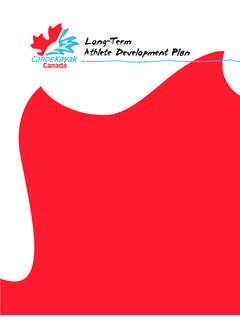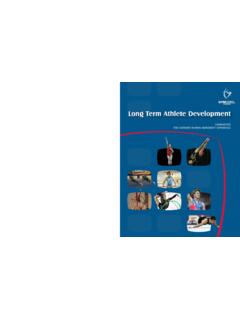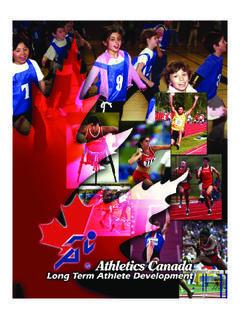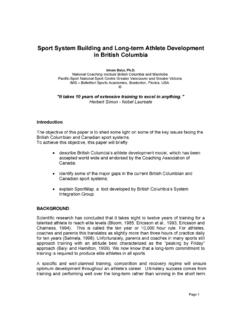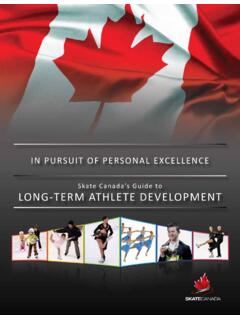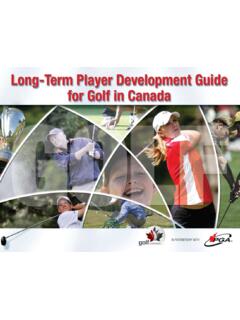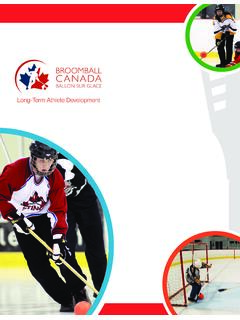Transcription of Cycling Canada
1 Cycling Canada long -Term Athlete development Mountain Bike Contents 1 Pathway to Success .. 1. 2 The MTB long -Term Athlete development Model .. 2. 3 Growth and development .. 4. 4 MTB Stage by Stage .. 6. 5 A Blueprint for Athlete development .. 23. 6 Conclusion .. 27. Glossary of terms .. 28. Resources and Contacts .. 30. Acknowledgements Cycling Canada thanks the following for their contribution to this document: Ian Hughes, MTB development Coach, Cycling Canada Dan Proulx, MTB Head Coach, Cycling Canada Mathieu Boucher, Performance development Director, Cycling Canada Paul Jurbala, Consultant, Cycling Canada Fran ois Billaut, INS Qu bec Rob Rupf, CSI Ontario Scott Kelly, Team Mechanic Scott 3 Rox Document edited and prepared by Paul Jurbala, communityactive Design: John Luimes, i. Design Group ISBN# 978-0-9809082-9-9. We acknowledge the financial support of the Government of Canada through Sport Canada , a branch of the Department of Canadian Heritage.
2 Ii Cycling Canada long -Term Athlete development : MOUNTAIN BIKE. 1 Pathway to Success Cycling is one of the world's great activities. Whether it is transportation, recreation, or competitive sport, BMX, Road, Mountain Bike (MTB) or Track, for able-bodied or Para- Cycling athletes , Cycling is participated in and loved by millions around the globe. Cycling Canada , formerly the Canadian Cycling Association, has existed for over one hundred years to promote cyc- ling in Canada , and to organize competitive Cycling in our country. We have a proud tradition of international competi- tive success including World Champions and Olympic medalists representing the highest level of competitive excel- lence. While we take pride in our competitive achievements, we also have a responsibility to keep our sport strong, to honour our traditions, and to help new generations of Canadians to achieve their dreams - whether that means helping them to join the ranks of our champions or simply enjoy all the pleasures and benefits of Cycling .
3 This document is a guide to MTB based on principles of long -Term Athlete development , and informed by our work on Gold Medal Profile for MTB. Along with all Canadian sport organizations, Cycling Canada has adopted the long Term Athlete development (LTAD) model as its framework for athlete and sport development . LTAD is based on sport science research combined with the practical experience of working with thousands of athletes and coaches to develop a comprehensive set of principles for effective athlete development . In fact LTAD is more than a model - it is a system and philosophy of sport development . LTAD recognizes the continuum of growth and participation in sport, from the earliest stages of developing physical literacy, through high performance, to lifelong participation. For competitive cyclists, LTAD means optimal training, competition and recovery programming with attention to biological development and maturation. LTAD is athlete-centred, coach-driven, and administration-supported.
4 Since athlete and participant development is at the core of the Cycling Canada 's mission, LTAD. is key to everything we do, whatever our role or level within the Cycling system. Our obligation is to help every Canadian cyclist fulfill their aspira- tions and be the best they can be. Our goal is not simply to help Canadian riders onto international podiums, but to ensure that every athlete can enjoy participation in Cycling for a lifetime. long -Term Athlete development : MOUNTAIN BIKE Cycling Canada . 2 The MTB long -Term Athlete development Model LTAD is a model of life- long development in which the athlete passes through stages, from Active Start to Active for Life. All individuals pass through the Active Start, FUNdamentals and Learn to Train stages from birth through adoles- cence, and acquire a critical foundation of physical literacy or competence in basic movement and sport skills. These are the stages of MTB for Fun and Skill.
5 From there they can progress into competition and go as far as their will and potential carry them. We call these the stages of MTB for Performance. Only a few reach the level of high performance in the Train to Win stage. The CCA LTAD Volume 1 document outlines the stages of development for cyclists including MTB and the Para- Cycling LTAD supplement has specific information for athletes with a physical disability. You can also find many other resources at MTB for Fun and Skill Young riders before puberty participating in stages of MTB for Fun and Skill are typically in the FUNdamentals or Learn to Train stages of LTAD. It is essential to understand that when working with young participants, we are not sim- ply preparing them for our sport, but for all sports- and that by offering well-rounded development that builds physical literacy, we are also preparing them for a more active, healthy lifestyle. Young athletes of the same chronological age can vary widely in their development , ability to learn skills, and emotional readiness for competition.
6 If we over-empha- size tactics when the athlete is not ready to learn or expose the athlete to intense competition, it can take the fun out of sport. Every young athlete deserves a program appropriate to his or her individual stage of development . MTB for Performance athletes in the MTB for Performance stages, from Train to Train through Train to Win, may be any age from puberty and older. They are focused on improving competitive performance, and developing the fitness, technical and tactical skills to attain success. Ideally these athletes have built a solid foundation of technical skills in the MTB for Fun and Skill stages, but if they have entered sport late or crossed over from other sports, they may need accelerated de- velopment in Cycling skills. MTB for Performance involves a higher level of commitment to the sport. The path becomes more challenging as the athlete progresses; success in international competition comes from deliberate practice, appropriate training and competition.
7 The LTAD model offers a progressive, periodized pathway that uses competition as a tool to achieve developmental goals, and integrates optimal nutrition, rest and recovery, and sport science as a basis for holistic athlete development . The objective is to maximize development by building skill and training capacity while minimizing overtraining and risk of injury. Ultimately everyone, whether they have simply learned the basics of MTB or completed a competitive career, can enjoy the sport at the Active for Life/Competitive for Life stage. Active life- long participation is one of the greatest benefits of our sport. Cycling Canada long -Term Athlete development : MOUNTAIN BIKE. Cycling MTB LTAD. SUCCESS: Be World Champion! TRAIN TO WIN: Perform on demand 8 - 10+ years in Cycling PERFO. STRATEGY: Be the smartest! TRAIN TO COMPETE: Build cmpetition skills RMANCE. ACTIVE FOR LIFE/. 5 - 7+ years in Cycling COMPETITIVE. FOR LIFE. enter at any age from any stage after SPEED: Build the engine!
8 Growth spurt TRAIN TO TRAIN : Build the engine 3 - 6 years in Cycling SKILL: Be a skill champion! LEARN TO TRAIN: Build winning MTB skills age: 9 (F) or 10 (M) to growth spurt FUN & SK. 1 - 5 years in Cycling Canadian Sport for Life START: Love to ride! ILL. FUNDAMENTALS: Basic sport skills age: 6 to 8 (F) or 9 (M). READY: Learn to ride! ACTIVE START: Basic movement skills age: 0 to 6. long -Term Athlete development : MOUNTAIN BIKE Cycling Canada . 3 Growth and development long -term Athlete development (LTAD) is a pathway for optimal training, competition and recovery throughout an athlete's career, but particularly in relation to the important growth and development years of young people. LTAD stages are based on sport years which is the time spent developing in sport. Most athletes require from 7. to 10 or more years in sport to reach peak performance. After puberty, the prior sport experience of the athlete, combined with his/her individual stage of physical, mental and emotional development , is much more important than chronological age in determining what the athlete is ready for.
9 However, while the overlap between sport years in each stage may suggest that athletes can progress through more than one stage per year it is strongly recommended the athlete not be pushed through more than one stage per year, no matter how exceptional they seem to be. It is also very important to take advantage of sensitive periods of adaptation as the child grows and develops. The mind and body are most able to develop in specific ways at specific times. Skills, for example, are learned quickly from about age 8 to 12. Physical strength, power and endurance can be developed after the growth spurt, also called Peak Height Velocity (PHV). See the glossary for definitions. Cycling Canada long -Term Athlete development : MOUNTAIN BIKE. Many athletes come to MTB after puberty, sometimes transferring from other sports. Even if the sensitive periods of adaptation were missed , all performance factors are always trainable. An expert coach will assess the key perform- ance factors for each athlete, and design a training program to accelerate certain aspects of development as needed.
10 The At a Glance chart on page 25 lists the performance factors for a MTB athlete and shows the main emphasis of each stage. Each stage is a foundation for the next, and competitive success can only be built on a strong foundation. Females PHV. Skills Speed 2. Speed Stamina Suppleness Strength 1&2. Rate of Growth Developmental Age CH R O N O L O G I C A L AGE. under 5 6 7 8 9 10 11 12 13 14 15 16 17 18 19 20+. PHV. Males Suppleness Stamina Skills Strength Speed 1 Speed 2. Rate of Growth Physical, Mental - Cognitive, Emotional development Diagram: Enhanced Periods of Adaptation in Relation to Rate of Growth (courtesy Canadian Sport for Life). long -Term Athlete development : MOUNTAIN BIKE Cycling Canada . 4 MTB Stage by Stage The following pages detail long -term athlete development for MTB, stage by stage. For each stage the main focus, three key objectives, and detailed information on how to develop a prime objective are provided.


